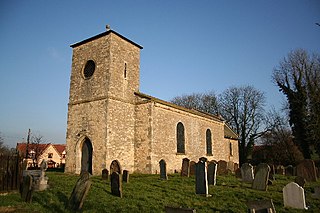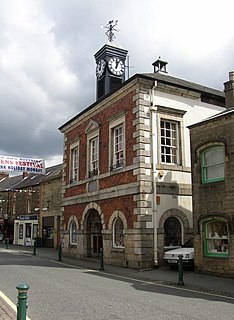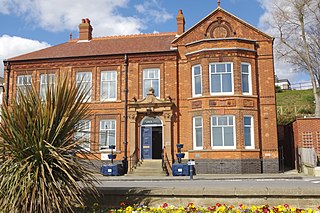
Welton is a village and civil parish in the West Lindsey district of Lincolnshire, England. The population of the civil parish was recorded as 4,327 in the 2011 census. It is geographically situated 6 miles (10 km) north from Lincoln city centre. The name Welton by Lincoln distinguishes it from other similarly named villages in Lincolnshire: Welton le Wold and Welton le Marsh.

Kirton or Kirton in Holland is an English village and civil parish in the Borough of Boston, Lincolnshire. The population of the civil parish at the 2011 census was 5,371.

Bottesford is a town in North Lincolnshire, Lincolnshire, England.

Kirton in Lindsey, also abbreviated to Kirton Lindsey, is a market town and civil parish in North Lincolnshire, England. It is 7 miles (11 km) south-east from Scunthorpe.

Willoughton is a village and civil parish in the West Lindsey district of Lincolnshire, England. It is situated 2 miles (3.2 km) west from the A15 road, 13 miles (21 km) north from Lincoln and 3 miles (5 km) south from Kirton Lindsey. According to the 2001 Census the village had a population of 330, increasing to 341 at the 2011 census.

William Haywood was an architect who worked in Lincoln, England. His father John who died in 1817 was mayor of Lincoln twice and worked as a mason. Haywood succeeded his father as mayor after his death in 1817. His grandfather, John Hayward (1708–78) was also a mason in Lincoln. William Hayward's great grandfather was Abraham Haywood an architect of Whitchurch, Shropshire who came to Lincoln around 1720. William Haywood succeeded William Lumby as Surveyor to Lincoln Cathedral in 1799 and Edward James Willson followed him in this position in 1823. William Hayward also succeeded William Lumby as Surveyor for the Lincolnshire County County Committee, which had responsibility for Lincoln Castle and the prison. Howard Colvin considered Hayward to be a competent designer in the ‘Regency’ style and that from the re-construction of Kirton in Holland church in 1804 had an understanding of Gothic architecture quite remarkable at that date. Hayward also rebuilt the tower of Wrangle church in a similar style in 1820.

Louth Town Hall is a municipal building in Eastgate in Louth, Lincolnshire, England. The structure, which was the meeting place of Louth Borough Council, is a Grade II listed building.

Corsham Town Hall is a municipal structure in the High Street, Corsham, Wiltshire, England. The structure, which serves as the meeting place of Corsham Town Council, is a Grade II listed building.

Long Eaton Town Hall is a municipal building in Derby Road, Long Eaton, Derbyshire, England. The town hall, which currently serves as one of two meeting places of Erewash Borough Council, is a Grade II* listed building.

North Tawton Town Hall is a municipal building in The Square, North Tawton, Devon, England. The town hall, which is the meeting place of North Tawton Town Council, is a Grade II listed building.

Stockbridge Town Hall is a municipal building in the High Street in Stockbridge, Hampshire, England. The structure, which is used as the meeting place of Stockbridge Parish Council, is a Grade II* listed building.

Garstang Town Hall is a municipal building in the High Street in Garstang, Lancashire, England. The structure, which currently accommodates two shops and a Royal British Legion Club, is a Grade II listed building.

Kirton in Lindsey Town Hall is a municipal building in the Market Place in Kirton in Lindsey, Lincolnshire, England. The structure, which is used as the offices of Kirton in Lindsey Town Council, is a Grade II listed building.

Aylsham Town Hall is a municipal building in the Market Place in Aylsham, Norfolk, England. The structure, which accommodates the offices and meeting place of Aylsham Town Council, is a grade II listed building.

Newbrough Town Hall is a municipal building in Stanegate in Newbrough, Northumberland, England. The building, which is used as a community events venue, is a Grade II listed building.

Beeston Town Hall is a municipal building in Foster Avenue in Beeston, Nottinghamshire, England. The building was formerly the offices of Beeston and Stapleford Urban District Council and is now used by the Redeemer Church.

The Town House is a municipal building in Union Street in Yeovil, Somerset, England. The building, which is the meeting place of Yeovil Town Council, is a Grade II listed building.

Hanley Town Hall is a municipal building in Albion Square in Hanley, Staffordshire, England. The building, which is used as the local register office, is a Grade II listed building.

The Old Town Hall is a former municipal building in the High Street in Wrentham, Suffolk, England. The building, which was the meeting place of Wrentham Parish Council, is a Grade II listed building.

Felixstowe Town Hall is a municipal building in Undercliff Road West, Felixstowe, Suffolk, England. The building is the meeting place of Felixstowe Town Council.






















